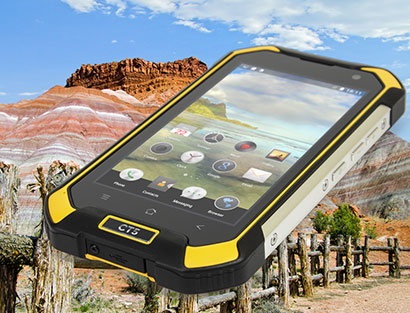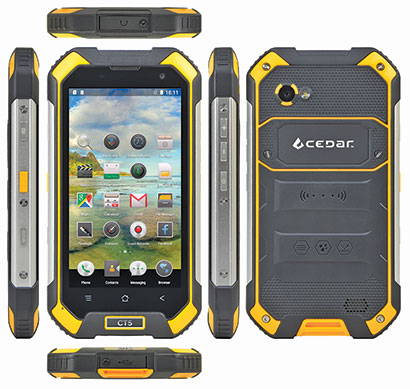The Cedar CT5 rugged handheld/smartphone was made available early 2017 by Juniper Systems as a more powerful and more technologically up-to-date successor to the earlier Cedar CT4.

The Cedar product line was launched by Juniper Systems to meet customer demand for a lower cost, ruggedized Android line that would serve as a more suitable alternative to fragile consumer devices for outdoor applications. One that was built from the ground up for ruggedness, supports the cell bands used in the United States (including 4G LTE), has a proper IMEI (International Mobile Equipment Identity) number for security, and one that has, of course, passed all the requisite FCC & CE compliance testing.
Below you can see what the Cedar CT5 looks like front, back and sides. It's an attractive, purposeful design instantly recognizable as a tool for the job. No need for a protective case here.

Measuring 6.0 x 3.2 inches (just a bit larger than the iPhone 7 Plus) and just 0.67 inch thick, the CT5 remains pocketable, and it weighs just eight ounces. Its 4.7-inch screen is the same size as that of the iPhone 7, and the display's 1280 x 720 pixel resolution almost matches that of the iPhone 7 (1334 x 750) as well. 312 pixels per inch is super-sharp, and it's an IPS (In-Plane Switching) screen, which means it has perfect viewing angles from all directions.
As for the technology under the hood, the Cedar CT5, which is based on Android 6.0 ("Marshmallow"), uses a 2.0GHz octa-core Cortex A53 MediaTek MTK6755 processor (also known as the Helio P10) and includes a 700MHz Mali T860 graphics processor. This is a popular chip used in devices from Sony (the Xperia XA Ultra), HTC, Lenovo and many others.
There's 3GB of RAM and 32GB of Flash for storage, plus what's in the micro SDHC card slot. There is an 13mp documentation autofocus camera with f/2.0 lens and LED flash on the backside, and a 5mp vidcam in the front. A powerful 16 watt-hour Li-Polymer battery is built-in and non-removable.
For wireless communication there's dual-band 802.11 a/b/g/n WiFi, Bluetooth 4.1, integrated GNSS (GPS/GLONASS/Beidou), as well as 2G, 3G and 4G LTE cellular radio. Wired communication includes a micro-USB port and a 3.5mm audio jack.
The CT5's housing and construction appears to be quite impressive. We haven't taken one apart yet, but the specs suggest a polycarbonate/fiberglass outer over an inner metal frame. For a rugged device the CT5 is quite thin, and the design, of course, allows for an attractive two-tone color scheme.
The Cedar CT5's dual micro SIM and micro SDHC card slots are user-accessible inside a compartment in the back of the unit. Each of the SIM slots is said to support GSM (850, 900, 1800, 1900), W-CDMA (900, 1900, 2100), and 4G LTE (Juniper tested 4G LTE for AT&T and T-Mobile, but there is no certification for the Verizon network).
For hardware controls, on its right side the CT5 handheld has the power button and volume up/down controls. Along the left side are three hardware buttons, one for Push-to-Talk, one for the camera, and one labelled SOS that can be programmed to send an emergency text to a contact. The three capacitive standard Android control buttons (Menu, Home, Back) are beneath the display.

Just how much tougher is the Cedar CT5 than your typical consumer smartphone? That's hard to say without hands-on, but probably quite a bit. Oddly, the drop spec is listed as just three feet, which seems hard to believe, especially given the predecessor's claimed ten feet.
The CT5 is claimed to have IP68 sealing, which means that it's totally dustproof and also protected against full and extended immersion in water. The manufacturer usually states how deep and for what duration, and that's not listed yet. The display is protected by Gorilla Glass 3 from breakage and scratching. What would be really good to have is a full listing of the usual ruggedness specs.
What's the price? We don't know yet. Cedar sold the predecessor CT4 for US$489, everything included. That was significantly less than the cost of an unsubsidized premium consumer smartphone. Customers might leave their expensive, fragile primary smartphone at home and use a tough Cedar CT5 instead for work on the road and in the field.






